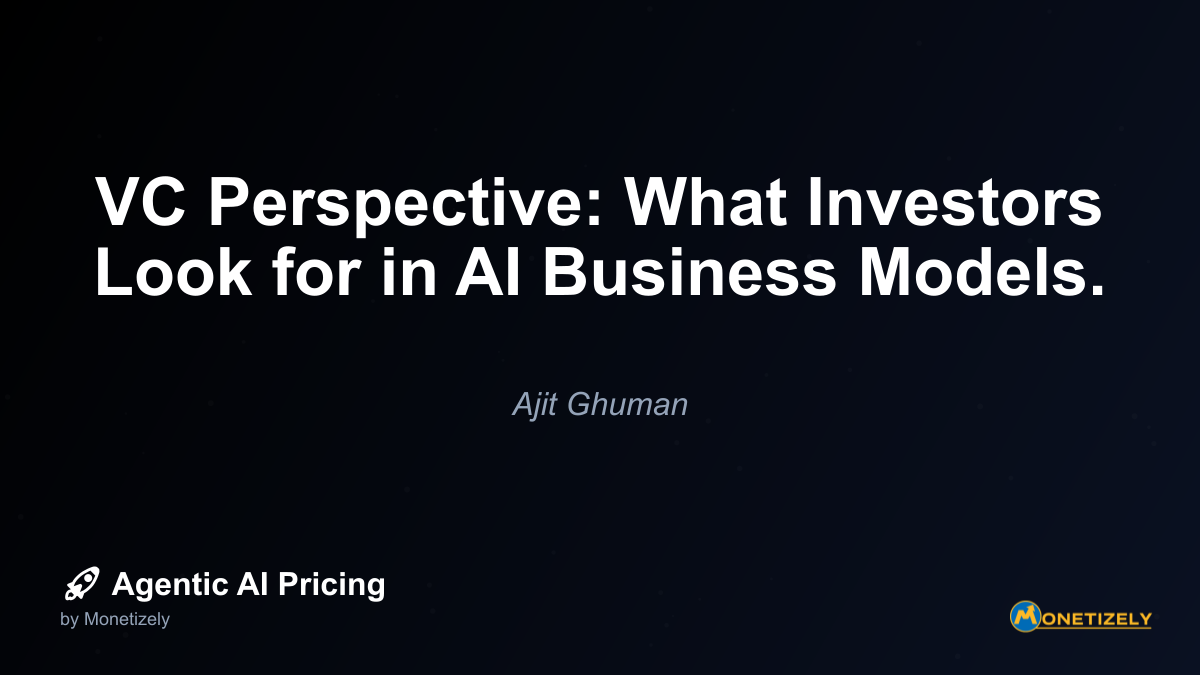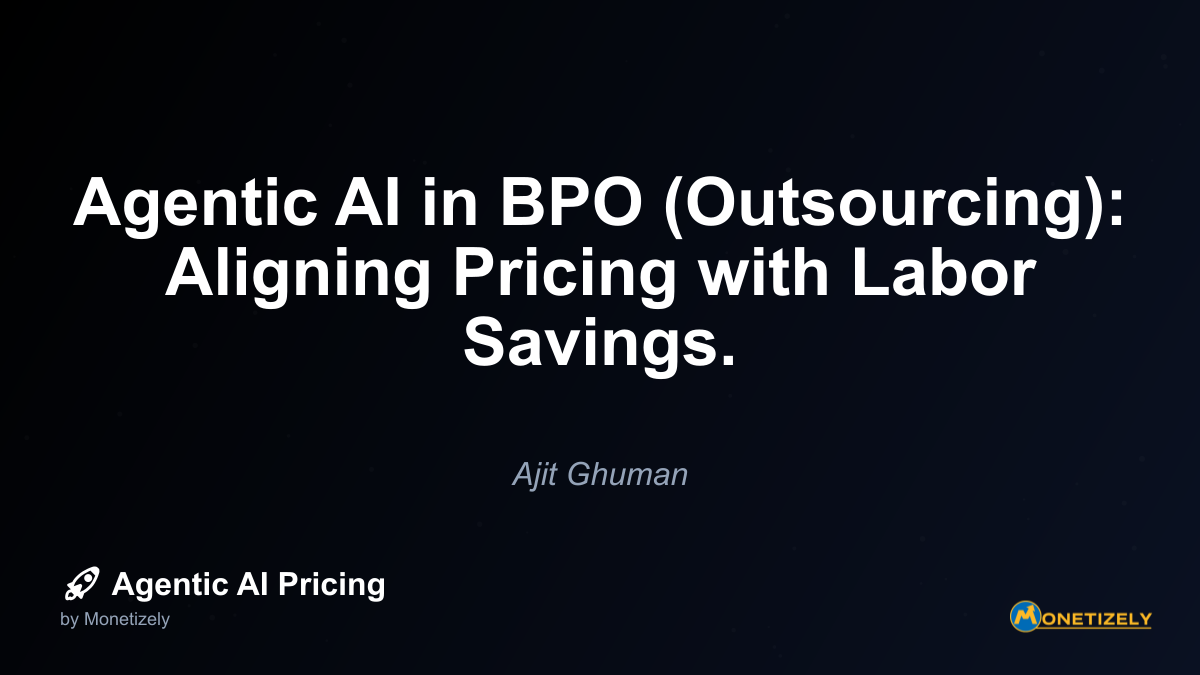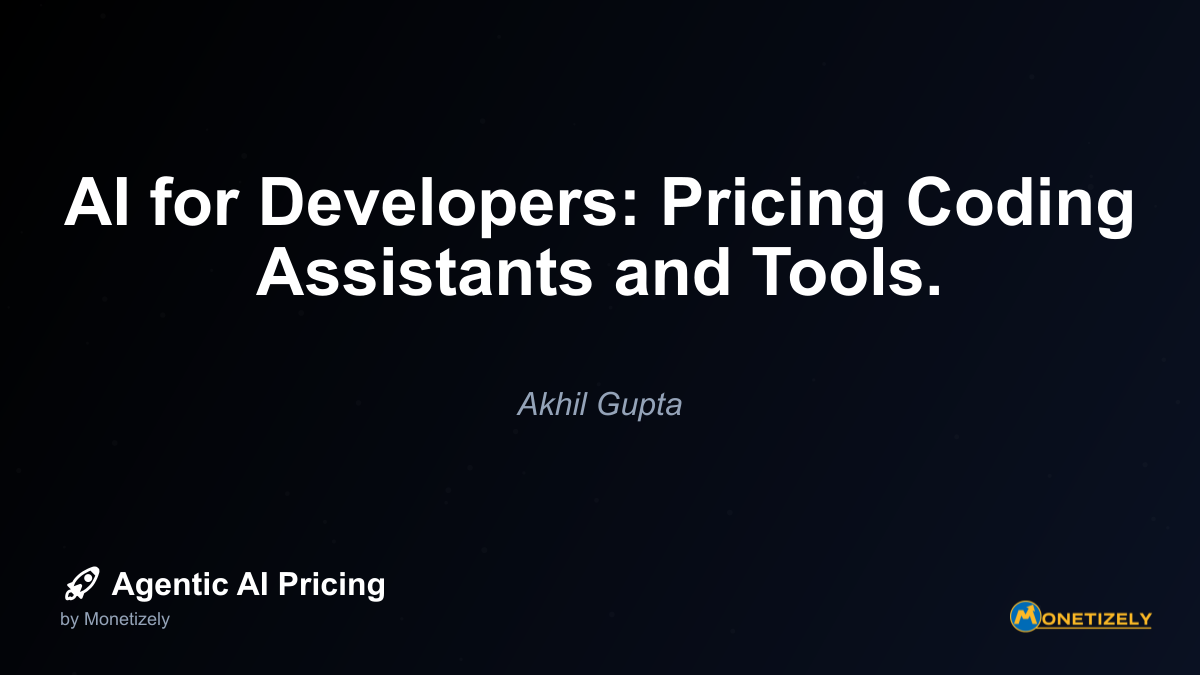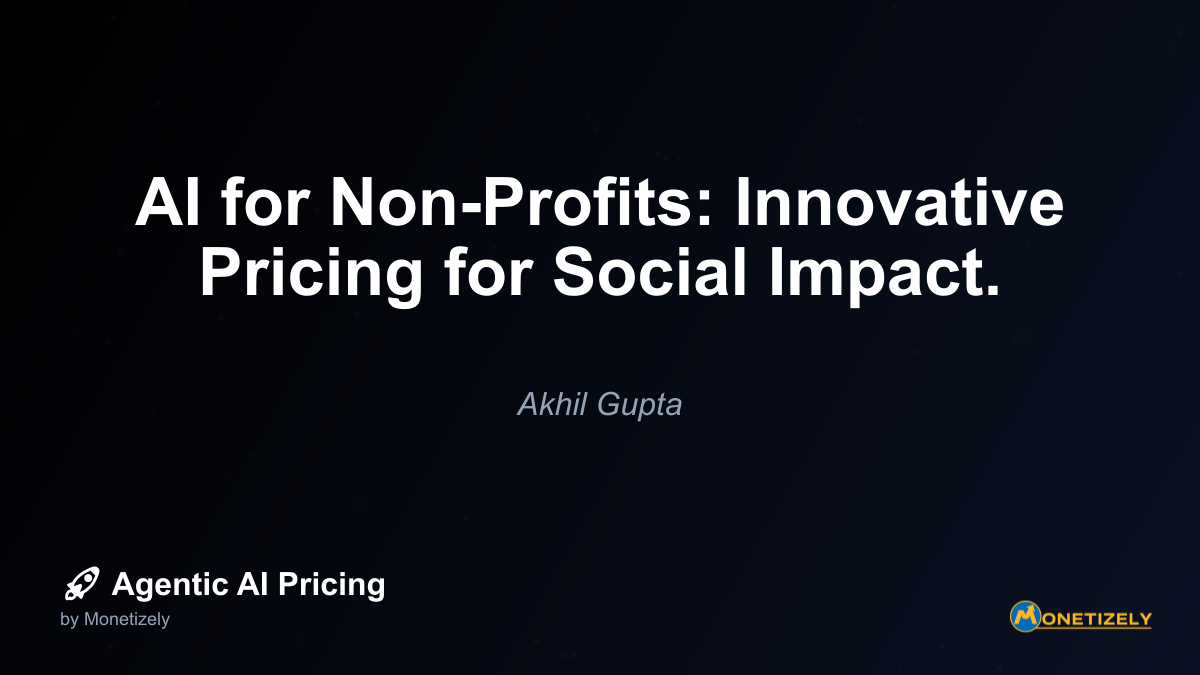· Ajit Ghuman · Industry Insights · 9 min read
VC Perspective: What Investors Look for in AI Business Models.
AI and SaaS Pricing Masterclass
Learn the art of strategic pricing directly from industry experts. Our comprehensive course provides frameworks and methodologies for optimizing your pricing strategy in the evolving AI landscape. Earn a professional certification that can be imported directly to your LinkedIn profile.

Venture capital has always been the lifeblood of technological innovation, but in the age of agentic AI, the relationship between investors and founders has evolved dramatically. As AI technologies transform industries and create new business categories, VCs are adapting their evaluation frameworks to properly assess these novel business models. Understanding what investors look for in AI ventures isn’t just valuable for founders seeking funding—it’s crucial for anyone working in the AI ecosystem to grasp how capital allocation decisions shape the direction of innovation.
The Shifting Landscape of AI Investment
The investment thesis for artificial intelligence has undergone several transformations. Early AI investments focused primarily on companies developing fundamental technologies and infrastructure. Today’s investors are increasingly interested in applications and solutions that leverage agentic AI capabilities to solve specific business problems with clear monetization paths.
This shift reflects the maturing AI ecosystem. We’ve moved from a period where simply incorporating machine learning into a product was novel enough to attract investment, to an environment where investors expect sophisticated business models that can capture the value created by AI systems while managing the unique costs and challenges these technologies present.
Scalable Recurring Revenue: The Foundation of AI Business Models
At the heart of what makes AI businesses attractive to investors is their potential for scalable recurring revenue. VCs are particularly drawn to subscription-based models (SaaS) and usage-based pricing structures that can grow exponentially while maintaining relatively fixed operational costs.
Why Recurring Revenue Matters to Investors
Recurring revenue provides predictability and visibility into future cash flows, which reduces investment risk. For AI companies specifically, investors look for:
Expanding revenue per customer over time: AI systems that become more valuable as they learn from user data create natural expansion opportunities.
Network effects: Solutions that improve as more users join the platform create defensible moats that competitors struggle to overcome.
Low customer acquisition costs relative to lifetime value: Investors scrutinize the economics of customer acquisition, expecting AI companies to demonstrate efficient growth metrics.
One prominent investor at Andreessen Horowitz noted: “The best AI companies don’t just sell technology—they sell outcomes that improve over time, creating ever-increasing value that justifies ongoing subscription payments.”
High Gross Margins Despite Compute Costs
The economics of AI businesses differ significantly from traditional software companies due to the computational resources required to train and run models. Investors recognize this fundamental difference but still expect healthy gross margins.
Balancing Compute Costs with Pricing Power
Successful AI companies demonstrate to investors that they can maintain 60-80% gross margins despite significant infrastructure costs. Strategies that impress investors include:
Efficient model deployment: Companies that optimize their AI systems to minimize computational resources while maintaining performance.
Strategic pricing architecture: Pricing structures that align with value delivery rather than computational costs.
Proprietary optimizations: Technical innovations that reduce compute requirements for specific applications.
Compute cost amortization: Spreading initial training costs across a large customer base and operating period.
A partner at Sequoia Capital recently emphasized: “We’re seeing the best AI companies separate the value they create from the cost of compute. They price based on business outcomes, not the resources consumed to deliver those outcomes.”
The Path to Profitability: Unit Economics That Make Sense
While venture capital has historically tolerated extended periods of losses in pursuit of growth, the bar for AI companies has been rising. Investors now expect a clear path to profitability, even if the timeline extends several years.
Key Profitability Metrics Investors Examine
Contribution margin per customer: After accounting for direct costs of serving each customer (including compute, storage, and customer support), what margin remains?
Payback period: How long does it take to recover the cost of acquiring a customer?
Operating leverage: As the business scales, do costs grow linearly with revenue, or can the company achieve economies of scale?
R&D efficiency: How efficiently can the company convert research and development spending into product improvements that drive revenue growth?
A general partner at Benchmark explained their perspective: “We’re looking for AI companies that can demonstrate improving unit economics over time. The initial costs might be high, but we need to see a clear trajectory toward sustainable margins as scale increases.”
Evidence of Customer Willingness to Pay
Perhaps the most compelling signal for investors is evidence that customers are not just using an AI product but are willing to pay meaningful amounts for it and continue using it over time.
Demonstrating Real Customer Value
Investors look for:
Paid pilots converting to full deployments: Early customer engagements that transition from experimental to production use.
Price sensitivity testing: Evidence that customers accept price increases as they recognize more value from the product.
Expansion within accounts: Existing customers increasing their usage or adding more seats/licenses over time.
Reference customers: Prominent customers willing to publicly endorse the product and its ROI.
A partner at First Round Capital noted: “We want to see evidence that customers see the AI solution as mission-critical rather than experimental. This usually manifests as strong renewal rates and growing contract values.”
Sticky Products That Drive Retention
Customer retention is particularly important for AI businesses because the economics often rely on long customer lifetimes to recoup acquisition and development costs.
Creating Defensible AI Products
The stickiest AI products typically share these characteristics:
Data network effects: The product improves for each user as more data is collected across the customer base.
Workflow integration: Deep integration into customer workflows creates high switching costs.
Customization and learning: AI systems that adapt to specific customer needs become more valuable over time.
API and ecosystem development: Products that become platforms with third-party integrations create multiple reasons for customers to stay.
As one Greylock partner put it: “We’re looking for AI companies that create systems of record or systems of intelligence that become increasingly embedded in how customers operate. The best AI companies don’t just sell features; they transform how work gets done.”
Differentiation in Crowded AI Categories
With the proliferation of AI startups, investors are increasingly focused on how companies differentiate themselves in crowded categories.
Standing Out in the AI Landscape
Investors favor companies that can articulate:
Proprietary data advantages: Unique datasets that enable superior model performance.
Novel technical approaches: Innovations in model architecture, training methods, or deployment strategies.
Domain expertise: Deep understanding of specific industries that informs product development.
Go-to-market advantages: Unique distribution channels or partnerships that accelerate customer acquisition.
According to a partner at NEA: “The most compelling AI pitches show why this specific team, with their specific approach, is uniquely positioned to win in their category. Generic claims about AI capabilities no longer impress investors.”
Regulatory and Ethical Considerations
As AI regulation evolves globally, investors are increasingly evaluating companies’ approaches to compliance and ethics as part of their due diligence.
Mitigating Regulatory and Ethical Risks
Forward-thinking AI companies demonstrate:
Compliance readiness: Architectures designed with regulatory requirements in mind.
Transparent AI practices: Clear documentation of model development, training data, and decision processes.
Risk management frameworks: Processes for identifying and mitigating potential harms from AI systems.
Ethical governance: Oversight structures that ensure responsible AI development and deployment.
A partner at Union Square Ventures emphasized: “Companies that treat AI ethics and compliance as core to their business rather than an afterthought are better positioned for long-term success as regulation inevitably increases.”
IP and Defensibility Strategies
In a rapidly evolving field where today’s innovation can become tomorrow’s commodity, investors scrutinize how AI companies protect their intellectual property and create sustainable competitive advantages.
Building Defensible AI Businesses
The most compelling strategies include:
Patent portfolios: Strategic patent filings that protect core innovations.
Data moats: Proprietary datasets that competitors cannot easily replicate.
Algorithmic innovations: Novel approaches to AI problems that deliver superior results.
Complementary human expertise: Combining AI capabilities with specialized human knowledge in ways that pure technology companies cannot match.
A partner at Index Ventures noted: “We’re increasingly interested in AI companies that create defensibility beyond just having good engineers. The best companies build structural advantages through unique data, network effects, or complementary assets that make their position stronger over time.”
The Team Composition Investors Favor
The composition of founding and leadership teams for AI companies differs significantly from traditional software startups, and investors have adapted their evaluation frameworks accordingly.
Building Compelling AI Leadership
Investors look favorably on teams that combine:
Technical depth: AI researchers or engineers with demonstrated expertise in relevant domains.
Product vision: Leaders who can translate technical capabilities into compelling product experiences.
Business acumen: Executives who understand how to build sustainable business models around AI capabilities.
Domain expertise: Team members with deep knowledge of the industries they’re targeting.
As one Lightspeed partner explained: “The ideal AI founding team bridges the gap between cutting-edge research and practical business applications. We’re looking for teams that can not only build impressive technology but also package it into products that solve real customer problems.”
Capital Efficiency and Funding Strategy
The capital intensity of AI businesses varies widely, and investors pay close attention to how efficiently companies deploy funding.
Demonstrating Capital Efficiency
Successful AI companies typically:
Stage appropriate development: Focus initial funding on proving core technical capabilities before scaling go-to-market efforts.
Strategic use of cloud resources: Thoughtful decisions about when to use managed services versus building custom infrastructure.
Clear milestone planning: Specific technical and business goals tied to funding rounds.
Balanced R&D investment: Appropriate allocation between fundamental research and product development.
A partner at Bessemer Venture Partners explained: “We expect AI companies to be thoughtful about capital allocation. The best founders understand when to invest in research, when to focus on product refinement, and when to accelerate go-to-market activities.”
Conclusion: The Evolving Investor Perspective on AI
The criteria investors use to evaluate AI businesses continue to evolve as the technology matures and market conditions change. What remains constant is the focus on fundamentals: evidence of customer value, sustainable unit economics, and defensible competitive advantages.
For founders building AI companies, understanding these investor perspectives is crucial for developing business models and go-to-market strategies that will attract capital. For established businesses incorporating AI, these frameworks provide valuable insights into how to structure and position AI initiatives.
As agentic AI continues to transform industries, the relationship between investors and innovators will shape which applications receive funding and which business models prevail. By focusing on scalable recurring revenue, maintaining healthy gross margins, demonstrating a path to profitability, and building products customers willingly pay for and stick with, AI companies can position themselves for success in this evolving landscape.
The most successful AI ventures will be those that not only push technical boundaries but also create sustainable business models that align technological capabilities with genuine customer needs. In doing so, they’ll continue to attract the capital needed to bring transformative AI solutions to market.
Co-Founder & CEO
Ajit is the author of Price To Scale, a top book on SaaS Pricing and is the Founder of Monetizely. Ajit has led and worked in pricing and product marketing at firms like Twilio, Narvar and Medallia. His work has been featured in Forbes and VentureBeat. Ajit regularly consults with software companies from Seed stage to post-IPO on pricing strategy. Ajit is also a highly-rated co-instructor for 'The Art of SaaS Pricing and Monetization' on Maven.
Pricing Strategy Audit
Let our experts analyze your current pricing strategy and identify opportunities for improvement. Our data-driven assessment will help you unlock untapped revenue potential and optimize your AI pricing approach.




